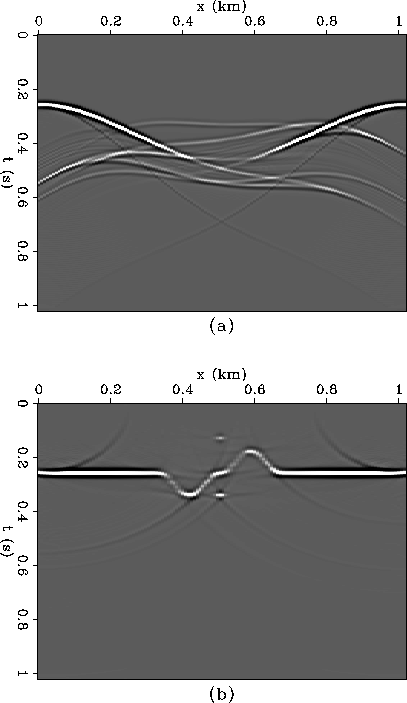




Next: Static Shift and Wave-Equation
Up: IRREGULAR TOPOGRAPHY
Previous: IRREGULAR TOPOGRAPHY
A zero-offset Kirchhoff modeling and migration program is used to
generate synthetic data on an irregular surface. The algorithm is
similar to trimo() Claerbout (1992) but
it incorporates topography. The effect of topography is examined
by performing static shifts, wave-equation datuming and migration on the
zero-offset synthetics. In actual practice data must be datumed pre-stack;
However, the zero-offset case is examined here because it is a first
step in gaining intuition into the problems encountered with irregular
topography and because it is easy to visualize what the zero-offset
synthetics should look like. Pre-stack datuming is discussed in
a subsequent section.
The model used in this section consists of an anticline, a syncline, and two
point diffractors in a constant velocity media. The medium velocity is
2 km/s.
The topography is modeled as
a cosine shaped mountain 200 m high
(Figure 5).
The effect of the mountain is to create a low frequency undulation
which completely distorts the synthetic data (Figure 6a).
The data are migrated using the conjugate of the program which created
the synthetic (Figure 6b). This type of migration requires
knowledge of the subsurface velocity structure. The problem with many
land data sets is that the topography distorts the data so much that it is
not possible to pick coherent reflection events or to estimate velocity.
model
Figure 5 Topography and subsurface structure used to generate the
zero-offset synthetic data.
|
|  |




 syn
syn
Figure 6 (a) The zero-offset synthetic data are distorted by the irregular acquisition
topography. (b) The synthetic data are migrated using an implicit
topographic correction. This requires knowledge of the subsurface velocity
structure.










Next: Static Shift and Wave-Equation
Up: IRREGULAR TOPOGRAPHY
Previous: IRREGULAR TOPOGRAPHY
Stanford Exploration Project
11/17/1997


